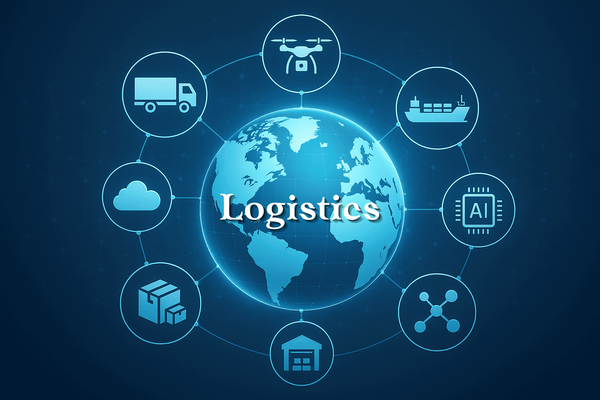Notifications
ALL BUSINESS
COMIDA
DIRECTORIES
ENTERTAINMENT
FINER THINGS
HEALTH
MARKETPLACE
MEMBER's ONLY
MONEY MATTER$
MOTIVATIONAL
NEWS & WEATHER
TECHNOLOGIA
TV NETWORKS
VIDEOS
VOTE USA 2026/2028
INVESTOR RELATIONS
DEV FOR 2025 / 2026
ALL BUSINESS
COMIDA
DIRECTORIES
ENTERTAINMENT
FINER THINGS
HEALTH
MARKETPLACE
MEMBER's ONLY
MONEY MATTER$
MOTIVATIONAL
NEWS & WEATHER
TECHNOLOGIA
TV NETWORKS
VIDEOS
VOTE USA 2026/2028
INVESTOR RELATIONS
DEV FOR 2025 / 2026
About Me
 Frank Nelson
Frank Nelson I'm Frank Nelson, a writer with a deep passion for technology, and a seasoned PHP developer with over a decade of experience building dynamic, high-performance web applications.
Frank Nelson 6 hours ago 27 views 0 Comments 0 Likes 0 Reviews fleet management logistics operations vehicle tracking transportation management fuel efficiency fleet optimization logistics tools delivery operations

Hey folks! 🚛 Whether you're managing a few delivery vans or a nationwide fleet of trucks, keeping your operations smooth, safe, and cost-effective is no easy ride. That’s where fleet management comes in—a core pillar in the modern logistics management system. So today, let’s roll up our sleeves and dive into what fleet management is, how it boosts logistics efficiency, and why it's becoming a must-have for smart businesses.
Managing commercial vehicles to ensure efficient, safe, and cost-effective transportation.
Fleet management is all about overseeing and coordinating a company's vehicle operations. From dispatching drivers and scheduling maintenance to tracking locations and fuel usage, it covers everything needed to keep the wheels turning without a hitch. Think of it like being the orchestra conductor for your fleet—ensuring every moving part is in tune and on time.
Whether it’s delivery trucks, service vehicles, or long-haul trailers, a logistics management software ensures you’re not just sending vehicles out into the wild—you’re optimizing their every move.
Fleet management isn't just nice to have—it's mission-critical. In logistics, where timing, safety, and cost control are everything, fleet oversight determines whether your deliveries land on time or not at all.
Poorly managed fleets lead to late deliveries, compliance risks, and skyrocketing costs. With the right system in place, companies improve delivery speed, maintain regulatory compliance, and significantly cut down on fuel and repair bills. It’s like adding cruise control to your logistics engine—steady, efficient, and reliable.
Real-time GPS tracking helps monitor vehicle location, reduce delays, and ensure route compliance.
Here’s the magic behind the scenes: GPS tracking uses satellites to pinpoint a vehicle's location anywhere on Earth 🌍. Each vehicle is equipped with a GPS device that continuously transmits data to a central platform—giving fleet managers a live map view of where their drivers are and where they’re headed.
This isn't just about dots on a map. The system collects detailed information, such as speed, direction, route taken, and stop times. It’s like having a bird’s-eye view of your fleet 24/7.
Real-time tracking isn't just cool—it’s game-changing. It allows dispatchers to detect delays instantly and reroute vehicles to avoid traffic or roadblocks. That means fewer headaches, more accurate delivery windows, and a better reputation.
Companies using GPS tracking report up to a 30% improvement in on-time deliveries. It also acts as a theft deterrent by instantly alerting managers to unauthorized movement. So you're not just faster—you're safer too 🛠️.
Ever had a customer call asking, “Where’s my delivery?” With GPS tracking, you can answer that with confidence. The system enables proactive communication—sending live updates, accurate ETAs, and delivery alerts directly to customers.
This transparency builds trust and cuts down on complaint calls. Imagine running a pizza shop and being able to show customers exactly where their pie is on the map—same concept, just on a bigger scale!
Fuel tracking helps slash consumption and support eco-friendly goals.
Monitoring fuel isn’t just about checking the gas tank anymore. Modern logistics management tool systems use telematics, fuel cards, and onboard sensors to give precise data on how much fuel is being used—and how it's being wasted.
Telematics connect vehicle data to a central system, showing fuel levels, consumption patterns, and even driver habits like idling. Fuel cards help track expenses and prevent misuse. Together, they form a powerful toolkit to tackle one of the biggest cost centers in logistics.
Fuel can make up 30% to 40% of a fleet’s operating budget, so every drop counts. Monitoring systems reveal where waste is happening—like excessive idling, speeding, or inefficient routes.
By fixing those habits, fleets can save thousands annually. One report showed companies reducing fuel usage by up to 15% within months of implementing tracking tools. That’s money back in your pocket and less fuel burned in the process. 💸
Absolutely. Sustainability isn't just a buzzword—it's a logistics priority. Fuel analytics reveal not just how much you're using, but how you can cut down. By optimizing driving patterns and reducing idle time, companies lower their carbon footprint 🌱.
Plus, having accurate emissions data makes it easier to comply with environmental regulations and report on green initiatives. It’s like tuning your fleet to run cleaner and leaner.
Analyzing driver habits leads to safer, smarter, and more efficient operations.
Driver behavior tracking digs deep into how vehicles are being handled. It monitors key activities such as:
Speeding
Harsh braking
Sharp acceleration
Idling
Route deviations
These insights help paint a clear picture of who’s driving safely—and who needs a little coaching.
Here’s where the rubber really meets the road. Safer drivers mean fewer accidents, which means lower liability and cheaper insurance. Insurers often offer discounts of up to 15% for fleets using driver monitoring systems.
And when incidents do happen, the data helps clarify what occurred—protecting both the driver and the company from false claims. It’s like having a digital witness in the passenger seat 🤖.
Definitely. Behavior data gives managers the fuel they need to create personalized coaching programs. Instead of generic training, drivers get insights on their own habits—and how to fix them.
Many companies also use this info to create reward systems, recognizing top drivers and boosting morale. After all, who doesn’t love a little friendly competition?
Fleet tools work better when they’re part of a bigger logistics ecosystem.
Fleet management doesn't work in a silo—it thrives when connected with logistics software like TMS (Transportation Management Systems), WMS (Warehouse Management Software), and ERP (Enterprise Resource Planning).
This integration allows data to flow freely across departments. When your warehouse knows exactly when the truck will arrive, operations get faster and smoother. Like gears in a machine, each system complements the other.
When systems talk to each other, you get real-time, cross-functional insights. That means better decisions on dispatching, routing, staffing, and inventory.
For instance, if a delay is detected by the GPS system, the TMS can automatically reroute another vehicle. That’s smart logistics in action—like having your chess pieces move themselves into better positions.
Integrated logistics platforms give you powerful KPIs like:
Cost per mile
On-time delivery rates
Fuel efficiency
Idle time percentage
Maintenance frequency
With this data at your fingertips, you can continually fine-tune your operations. The result? Lower costs, higher efficiency, and happy customers.
Fleet management isn’t just about moving vehicles—it’s about moving smarter. In a world where timing, safety, and efficiency can make or break your logistics game, having a solid system in place is your secret weapon.
Fleet management software streamlines vehicle operations and lowers costs
GPS, fuel, and behavior analytics improve efficiency and safety
Integration with logistics systems supports real-time optimization
Essential for fast, responsive, and eco-conscious logistics
Even small fleets can benefit from fleet management software. Generally, if you're managing five or more vehicles, it's worth the investment. It helps monitor operations, reduce fuel use, and increase driver accountability no matter the fleet size.
Yes, fleet tracking systems are designed to be compliant with privacy regulations. They typically monitor vehicle data, not personal information, and companies must inform drivers of tracking policies to remain transparent and legal.
Companies often see a return on investment within the first year of implementation. Savings come from reduced fuel consumption, improved vehicle lifespan, fewer accidents, and more efficient delivery scheduling, making it a smart long-term strategy.
Absolutely. Small logistics businesses can benefit just as much—if not more—from fleet management tools. These systems provide visibility and cost-saving opportunities that help level the playing field with larger competitors.
Fleet data should be reviewed weekly or monthly, depending on the operation’s size. Regular analysis helps spot trends, address issues early, and continuously improve performance and efficiency in the logistics pipeline.

Comments